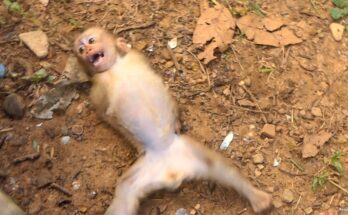The title “TPoor baby monkey fell from above” captures a moment of sudden panic and heartbreak — a tiny life separated from safety in the blink of an eye. In this scene we meet a small, fragile infant whose world is turned upside down when it slips or is pushed from the high branches it called home. The fall is quick; the aftermath lingers. Feathers of leaves and dust settle while nearby adults freeze — some in shock, some rushing toward the sound of a small body striking the ground.
The description follows the baby’s fragile struggle: tiny limbs splayed, chest heaving with frightened breaths, eyes searching for the familiar face of its mother. Nearby family members call out in alarm, their voices blending into an urgent chorus as they close ranks. A strong adult mother or guardian fights through the undergrowth, scooping the infant into protective arms. For a long, tense minute the group watches for signs of serious injury — limpness, uncontrolled crying, or a difficulty in moving. The community’s instinct is the same: shelter, warm, and check the baby; the group’s social bonds are at their most visible.
Emotion runs high — compassion, fear, relief — as caregivers gently clean and test the little one. The scene can be a raw reminder of how vulnerable newborns are and how essential family and community care remain. Whether the baby recovers fully or needs extended attention, the fall becomes a catalyst for cooperation among the troop: shared vigilance, protective positioning in trees, and teaching younger members to be more careful. This story is ultimately about fragility and resilience — a small life narrowly saved by the swift, loving response of its family, and the quiet lesson the group carries forward to protect their next generation.


